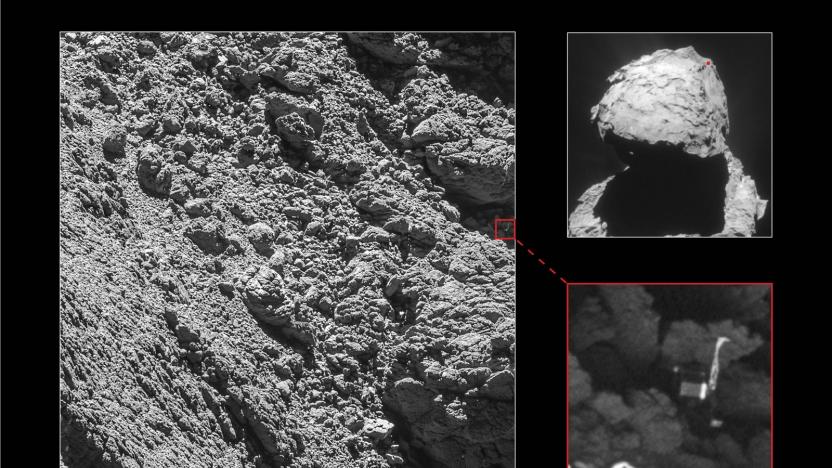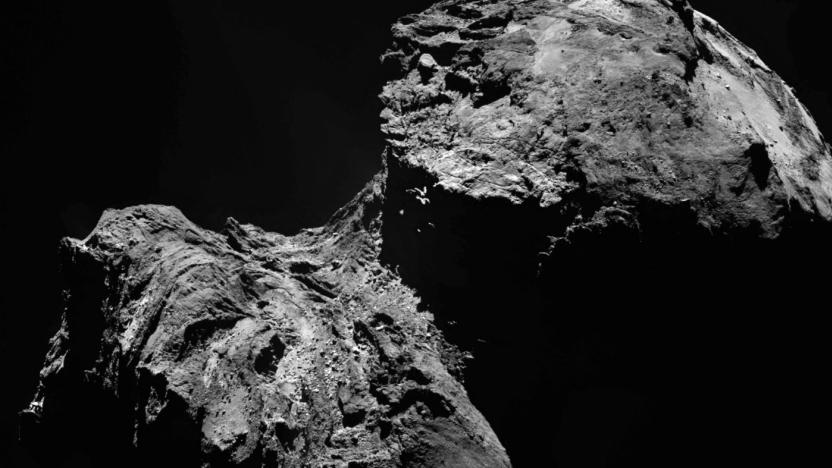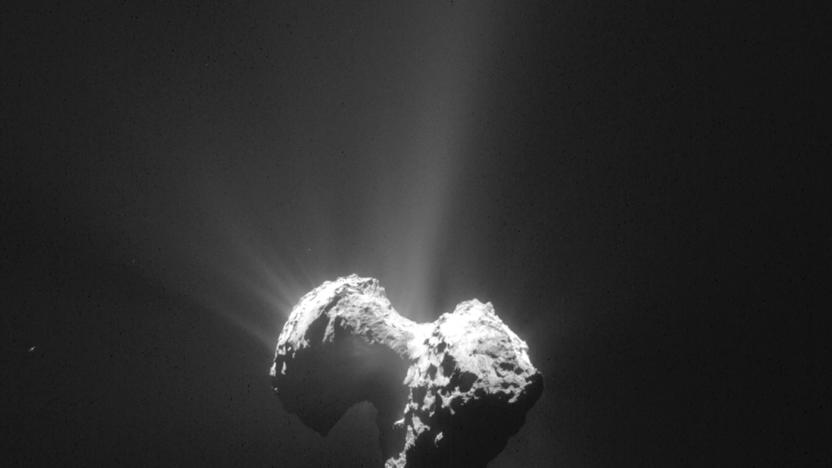Churyumov-Gerasimenko
Latest

Rosetta probe's last surprise: a photo of its landing site
Since it's been a year since Rosetta landed on the comet it orbited for a couple of years, you'd think the ESA had already decoded everything the vessel sent back before its demise. Apparently, the probe has one last surprise for all of us: a close-up photo of its final landing site. The team keeping an eye on the probe's OSIRIS camera thought they'd already downloaded all the images Rosetta took during its descent. Turns out the last photo's transmission got interrupted before it was done.

Rosetta probe belatedly finds the Philae comet lander
You have to sympathize with the European Space Agency. It's less than a month away from crashing its Rosetta probe into its host comet, and it just found the Philae comet lander -- you know, the machine the mission team stopped trying to contact back in July. Photos show that the lander get stuck in a dark crack on the comet in a position that prevents it from getting sunlight, revealing exactly why it went to sleep after a mere three days of activity. The ESA has had a general idea of where Philae was, but the low-resolution photos available before now made it hard to pinpoint the machine's location.

Rosetta will crash into its comet and die on September 30th
Farewell, young spacecraft. The European Space Agency's Rosetta probe has been surveying Comet 67P (or Churyumov-Gerasimenko) for the past 12 years, and on September 30th it will crash into the space rock and end its mission. Rosetta is nearing the orbit of Jupiter, which means it's running short on solar power and bandwidth required to downlink necessary data.

Rosetta finds key building blocks of life in comet dust
The amino acid glycine, one of the key building blocks of life as we know it, has been found in the "fuzzy atmosphere" of comet 67P Churyumov-Gerasimenko, the European Space Agency announced today. The findings mean it is likely the glycine was carried through space on the surface of the comet.

ESA makes an easy-to-view archive of new Rosetta comet images
The Rosetta probe has finally beamed back the photos (among other data) it took of 67P/Churyumov–Gerasimenko, as it flew within just 19 miles of the comet's surface. They were captured by the probe's main imaging system called OSIRIS, which is comprised of one narrow-angle and one wide-angle camera, from June 20th to September 16th, 2014. The spacecraft has gone closer to the comet since then, but the photos illustrate what the probe was seeing as it approached the celestial body.

Philae comet lander goes silent once again
It looks like the Philae comet lander's moment in the sun was short-lived. Just weeks after getting back in touch, the European ground crew has once again lost contact with its celestial explorer -- the lander is sending irregular bursts of data, but that's about it. It's not clear as to what went wrong, but scientists suspect that comet gas or some other unexpected phenomenon moved Philae and blocked it from collecting that all-important, energy-giving sunlight. To make matters worse, one of its transmitters also appears to be out of commission.

Europe's Philae comet lander finally wakes up
After seven months of not-so-voluntary deep sleep, the comet lander Philae has finally woken up in earnest. The European Space Agency got in contact with its explorer for 85 precious seconds late on June 13th, receiving 300-plus data packets that shed light on what happened following the machine's bumpy touchdown. As it turns out, Philae came back to life at least temporarily during its forced hibernation -- it just couldn't get back in touch with its Rosetta host ship and thus the ground crew.

Comet lander offers fresh insights about planet formation
The Philae comet lander might be slumbering, but it can still teach you a thing or two about the nature of celestial bodies. European Space Agency researchers have compared Philae's data against the more distant Rosetta probe, and they've discovered that Comet 67P/Churyumov-Gerasimenko isn't magnetized. If it's representative of other comets, that suggests that magnetic fields aren't nearly as important in planetary formation as scientists thought -- these clumps of dust are forming simply through collisions, and magnetism only factors in when there's enough material for gravity to take over. It could take a long while before there's stronger proof of that theory, but it's already clear that some previously-held beliefs about comets were off the mark.

The Big Picture: Rosetta gets up close and personal with a comet
Thought the Rosetta probe's earlier comet snapshots were special? They don't have a patch on its latest photo session. The ESA spacecraft went on its first dedicated close flyby of Comet 67P/Churyumov-Gerasimenko this weekend, and the images it captured have revealed a whole new level of detail. The picture you see above was taken a mere 5.5 miles above the comet's surface, and shows how the landscape varies wildly over short distances. You'll see everything from relatively smooth plains to fractured hills in a span of just 0.8 miles -- unlike a planet, there's no significant gravity (or many other factors, for that matter) to shape the terrain. Be sure to savor this imagery while you can, by the way. Rosetta's next goal is to get a long-range shot from 158 miles out, so you won't be getting more close-ups any time soon. [Image credit: ESA/Rosetta/NAVCAM]

Heels made from aluminum foam, designed by the cosmos
These are the shoes we'd imagine Lady Gaga would wear if she were Cinderella. As much as they look like crumpled aluminum foil, though, their designers, Azusa Murakami and Alexander Groves, were inspired by something a lot bigger: the rough surface of Comet 67P/Churyumov-Gerasimenko, where ESA's Philae lander is currently sleeping. In the absence of actual Churyumov-Gerasimenko samples, the duo collectively known as Studio Swine, 3D-scanned meteorites at the Natural History Museum in London after securing sponsorship from Microsoft. They meshed various scanned surfaces together and formed the shoes' base shape using aluminum foam. A CNC mill then scooped out part of the structure for the wearer's feet (these are shoes, after all), which was then lined with soft Italian leather. Despite the rugged ultra-metallic look, the designers claim these heels are nearly weightless, as aluminum foam is 90 percent air. We guess fashion doesn't always have to hurt after all. [Image credit: Studio Swine]

Sweet dreams, Philae: ESA's lander goes to sleep in the absence of sunlight
ESA's comet lander Philae has ran out of batteries and gone to sleep at 7:30PM on November 14th, 2014. It was supposed to harness solar energy to continue its operations, but it unfortunately bounced twice during touchdown and settled in the shade. That doesn't mean the project failed, though -- before the machine's power source ran out, the ground crew decided to throw caution to the wind and proceed with the more physical parts of material gathering. See, after landing in a less than ideal position, the team thought it best to just collect molecules from the comet's surface and perform the experiments (about 80 percent of the total number) that didn't require mechanical movement.

ESA's comet lander is stuck in the shadows (and it needs solar power)
When the Philae lander reached the comet 67P/Churyumov-Gerasimenko after a decade in space, the ESA expected it to draw energy from the sun to power its scientific instruments. Unfortunately, it's now stuck in the worst place possible: in the shade, where it's exposed to the sun only three hours per day. According to the probe's lead scientist Jean-Pierre Bibring: "We are exactly below a cliff, so we are in a shadow permanently." In order for the lander to continue collecting samples and crunching data to beam back to Rosetta, it needs at least six to seven hours of daily sunlight. It's been sniffing and analyzing molecules from the comet's surface thus far, but once its main batteries run out on Saturday (they can only power the lander for 64 hours from the time it separated from Rosetta), it'll have to lay in hibernation unless its situation somehow improves.

Rosetta's Philae lander touches down on comet after 10-year quest (update: new image)
After Rosetta's 10-year journey -- capped off with the smooth 7-hour descent of its Philae lander -- an explosion of elation went up in the European Space Agency's mission control center in Darmstadt, Germany. At around 11:04AM Eastern Time, humanity has, for the first time in history, carefully coaxed an extension of itself onto the surface of a comet. The first few moments after landing turned tense as the ESA team worked to determine if everything worked, but Philae Lander Manager Stephan Ullamec broke the strained silence. "The harpoons have been fired and the landing gear has been moved inside. We're on the surface. Philae is talking to us, more data to come," he said. Spacecraft operations manager Andrea Accomazzo (whom the internet started calling "ESA Hoodie Guy") couldn't quite help himself. "We can't be happier than we are now," he yelped. Update: ESA just released the first image from Rosetta on the surface of the comet (above) with one of its three feet visible in the foreground. The full panorama will be available at 2PM ET.



